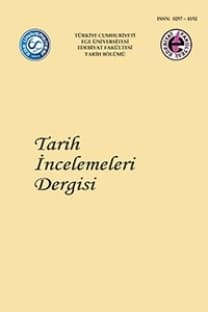19. Yüzyılın İkinci Yarısında Rusya, Osmanlı Devleti ve İran Arasında İran Transit Ticaretinin Gelişimi
İran transit ticareti hem Osmanlı Devleti hem de Avrupa ekonomileri için hammaddelere erişim anlamında büyük bir öneme sahip olmuştur. Bu ticaret 18. yüzyılın son çeyreğine kadar büyük ölçüde Osmanlı Devleti’nin kontrolündedir. 1774 yılındaki Küçük Kaynarca Antlaşması ile birlikte bu tekel hakkının kaybedilmesi ve Rusya’nın Kafkaslar üzerinde kurduğu tedrici hakimiyet, söz konusu transit ticaretin takip eden dönemde Osmanlı Devleti ve Rusya arasında büyük bir problem dönüşmesine neden olmuştur. Bu çalışmada İran transit ticaretinin 19. yüzyıldaki seyri, Osmanlı Devleti tarafından bu transit ticaretin farklı bir güzergaha sapmasını önleme ve Rusya tarafından da kendi topraklarına çekme şeklinde kendisini gösteren farklı sahalardaki politika tedbirleri bağlamında değerlendirilmektedir. Bununla birlikte bölgesel ticaretin bu rekabet süreci altındaki gelişimi, birincil kaynaklardan istifade ederek ortaya konulmaya çalışmıştır. Bulgular, İran’ın kuzeyindeki ticari faaliyetlerin tedricen Rusya tarafından ele geçirildiğini ve Osmanlı hükümetinin içerisinde bulunduğu kısıtlar bağlamında ihtiyaç duyduğu girişimleri gerçekleştiremediğini ve bunun sonucunda Batı ile İran arasında alternative güzergahların ortaya çıktığını göstermektedir.
Anahtar Kelimeler:
Osmanlı Devleti, Rusya, Iran transit ticareti, 19. Yüzyıl, Avrasya İktisat Tarihi.
The Development of the Transit Trade of Iran in the Triangle of Russia, Ottoman Empire and Iran In the second Half of the 19th Century
The transit trade of Iran had great importance for both the Ottoman Empire and the European economies for accessing raw materials. This trade had largely been under the control of the Ottoman Empire until the last quarter of the 18th century. The loss of this monopoly according to the Treaty of Kuchuk Kainarji in 1774 and the gradual domination of Russia over the Caucasus turned the transit trade of Iran into a big problem between the Ottoman Empire and Russia in the following period. In this study, the course of the transit trade of Iran in the 19th century will be evaluated with its development in different areas within the context of the policy measures taken by the Ottoman Empire to prevent the diversion in the transit trade and taken by Russia to attract this trade to its territory. Concordantly, the development of regional trade under this competition is aimed to be set forth using primary sources. The findings show that the commercial activities in the north of Iran were gradually seized by Russia, and the Ottoman government could not realize the attempts needed under the constraints it had, which resulted in and the emergence of alternative routes between the West and Iran.
Keywords:
Ottoman Empire, Russia, the transit trade of Iran, 19th Century, Eurasian Economic History.,
___
- Turkish Presidency State Archives of the Republic of Turkey – Department of Ottoman Archives
- Hariciye Nezareti Tercüme Odası (HR. TO.), 464/7, H. 12.9.1295/M. 09.09.1878.
- Sadaret Mühimme Kalemi Evrakı (A. MKT. MHM.), 460/6, H. 04.06.1290/M. 30.07.1873.
- İrade Dahiliye (İ. DH.), 400/26466, H. 25.08.1274/M. 10.04.1858.
- İrade Dahiliye (İ. DH.), 598/41651, H. 02.06.1286/M. 09.09.1869.
- İrade Dahiliye (İ. DH.), 614/42780, H. 01.04.1287/M. 01.07.1870.
- Hariciye Nezareti Siyasi (HR. SYS.), 1363/16, H. 29.03.1289/M. 06.06.1872.
- Meclis-i Vükela Mazbataları (MV.), 5/75, H. 15.01.1303/M. 24.10.1885.
- ISSN: 0257-4152
- Başlangıç: 1983
- Yayıncı: Prof. Dr. Süleyman Özkan
Sayıdaki Diğer Makaleler
Nokta ve Ünlem Savaşı: Yeni Gerçeklik ve Karabağ: Karabağ’a Düşen Cemre
Teğmen Herbert Chermsıde’ın Raporlarında Keldaniler, Nasturiler, Yezidiler ve Kürtler (1881-1882)
Tonkin (Vietnam)’daki Le-Trinh Döneminde Diarşi Sistemi Üzerine Bir İnceleme (17.-18. Asırlarda)
Zarifa NAZIRLI, Abdurrahman BOZKURT
Bilcan GÖKÇE, Rıfat KUVANÇ, Bülent GENÇ
Demokrat Parti’nin İlk Kadın Milletvekili: Hatice Nazlı Tlabar (1913-1971)
Ortaçağ Müslüman Devletlerinde Hayvanat Bahçeleri
DEMOKRAT PARTİ’NİN İLK KADIN MİLLETVEKİLİ: HATİCE NAZLI TLABAR (1913-1971)
Sultan Melikşah’ın Eşlerinden Çağrı Bey’in Torunu Zübeyde Hâtun
